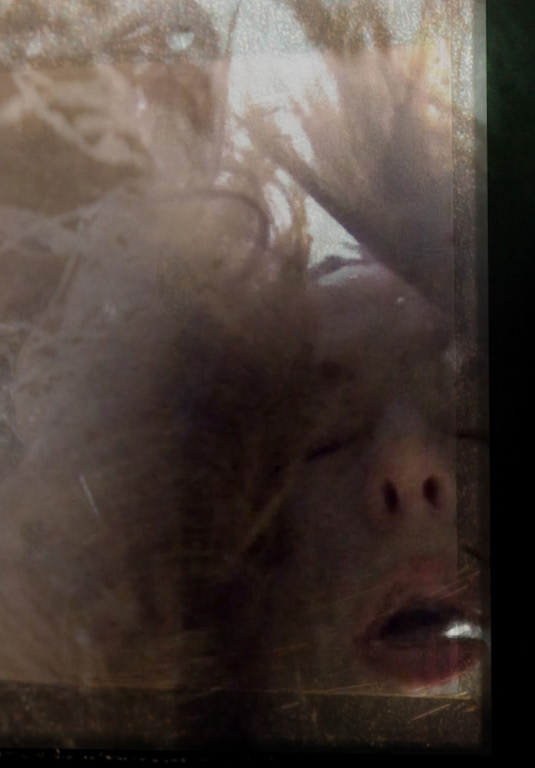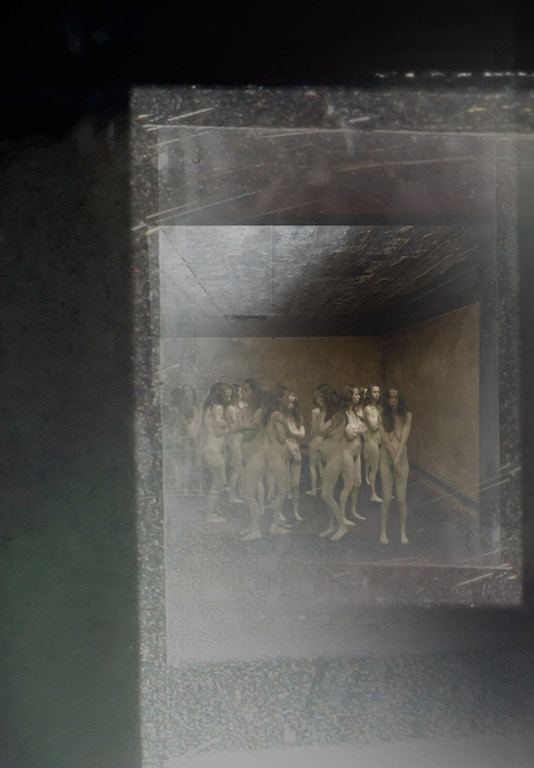

Wardrobe (War Machine) and Shoreline are related works that explore the war machine as described by Deleuze and Guattari in A Thousand Plateaus: Capitalism and Schizophrenia.1 Seen originally as a nomadic construct, when appropriated by the state, the war machine takes war as its primary object becoming striated and arborescent. This move to total war is closely connected to capitalism through the investment of capital into the war economy in the form of equipment, industry and people. The worldwide war machine is postfascist, taking peace as its object in the form of terror and survival, recognising an unspecified enemy. It is fed by capitalism that promotes both growth and consumption.
At the Wither Marxism? conference, California, 1993, where the term hauntology was first used, a conference aimed at exploring the future of Marxism following the fall the Berlin wall in 1989, Derrida states ‘the world is going badly’. Twenty three years on we live in an age of digital capitalism and according to Michael LePage, writing for the New Scientist in 2015, we face a mass extinction of the Anthropocene, the geological era that began with the industrial revolution and defined as the period when human activity began to have a profound global impact.2 The concept of hauntology, both in its original meaning taken from Spectres of Marx where Derrida suggests that ‘time is out of joint’ and that we are haunted by spectres of those dead and those not yet born, as well as Mark Fisher’s interpretation that mourns the lost futures of the twentieth century, suggesting we live in a time of mental illness, unable to envisage a future that is different to current times, describes the attitude of the contemporary collective unconscious. The internet has brought an explosion of information including historical evidence of human atrocity, and a plurality of viewpoints evidencing the propagandist nature of the state media apparatus. J. G. Ballard’s short story Billennium from the anthology Terminal Beach describes a world with a population so large that each person has an allocated living space of ‘four foot square’.3 As family units have a slightly higher space allocation there is still an incentive to breed.
At a time when the state is acting to reduce the living space allocation to three and a half feet per person, the protagonist finds a secret room at the back of his cubicle that has been accidentally boarded up.
I was reminded in this of several dreams I have had where I have discovered additional rooms in places I was living. On speaking to others I found this was not an uncommon dream.
Psychoanalysis tells us that dreams represent repressed unconscious desires.4 Cognitive psychology has demonstrated that much of what we consider to be volitional is underpinned by automaticity, suggesting that despite the seeming dominance of consciousness and apparent control of our actions, humankind operates at an instinctual level.5 Dreams are thought to be pre-linguistic in evolutionary terms and metaphor is the original language of thought.6 As such art promotes a form of communication that is innate, pluralistic in meaning, and capable of revealing hidden dimensions of thought.
Freud describes the uncanny as ‘that class of the terrifying which leads us back to something long known to us, once very familiar, [...] something which ought to have been kept concealed but which has nevertheless come to light’.7 Although these works were not made specifically to produce an uncanny response, the unconcept permeates. For me Wardrobe and Shoreline hint at something hiding in plain sight, something to be viewed askance.
The work, of course, also references C. S. Lewis’ The Lion, the Witch and the Wardrobe, a classic Christian allegory about the forces of good and evil.8 Again, in the allegory there is the idea of that which is hidden or veiled.
The work is constructed through playful association of the ideas and influences above, and is intended to invite an open ended reading. Deleuze and Guattari’s notion of the war machine is not clearly defined and has two opposing poles, one of domination, destruction, and war, and the other a creative line of flight, a smooth, nomadic space, the war machine as artistic movement. The dialogic elements presented in this project should be viewed as a rhizome including C. S. Lewis, J. G. Ballard, Deleuze and Guattari and the contributors who spoke of their dreams. Our dreams and phantasy life are largely private yet they can reveal similarities between us including modes of thought that could inform us of our behaviour. As such this work intends to promote openness, especially around difficult subjects usually cloaked in silence.
...
1 Gilles Deleuze and Felix Guattari, ‘1227: Treatise on – Nomadology–The War Machine’, Anti-Oedipus: Capitalism and Schizophrenia, trans. by Robert Hurley, Mark Seem and Helen R. Lane, (Minneapolis: University of Minnesota Press, 1983) [L’Anti-Oedipe, Paris: Les Editions de Minuit, 1972],pp. 351–421.
2 Michael LePage, After the Fall, The Big Questions, The Collection, New Scientist, issue 1, 2015, 72–77.
3 J.G. Ballard, ‘Billennium’, Terminal Beach, (Harmondsworth: Penguin, 1964),pp. 177–193.
4 Sigmund Freud, The Interpretation of Dreams (1899), The Standard Edition of the Complete Psychological Works of Sigmund Freud, vol. 5, trans. and ed. by James Strachey et al., (London: Hogarth, 1955).
5 Benjamin Libet demonstrated that unconscious processes initiate volitional acts. He used an electro-encephalogram (EEG) to record neuronal activity alongside an electromyograph (EMG) to record muscle movement in a button pressing experiment that showed muscle activity preceded conscious intension. Libet’s experiment has been variously interpreted and criticised but, as described by Patrick Haggard at The New Scientist Live: Consciousness Conference, London: the British Library, 12 September 2015, further research has shown that rather than consciousness being post-hoc confabulation, the decrease in discrepancy between response time and perceived action when choice is introduced into the experiment point to a more likely account that free-will and conscious intention are a part of human behaviour but the degree to which our actions are largely unconscious motor responses shouldn’t be underestimated. See B. Libet, Unconscious cerebral initiative and the role of conscious will in voluntary action, Behavioural and Brain Sciences, Vol. 8, 529–566, 1985, and John A. Bargh and Melissa J. Feruson, Beyond Behaviourism: On the Automaticity of Higher Mental Processes, Psychological Bulletin, 2000, Vol. 126, No. 6, 925–945.
6 Irving Massey, The Neural Imagination: Aesthetic and Neuroaesthetic Approaches to the Arts, (Texas: University of Texas Press, 2009), p. 79.
7 Sigmund Freud (1919), “The ‘Uncanny’”, in The Standard Edition of the Complete Psychological Works of Sigmund Freud, vol. 17, trans. and ed. by James Strachey et al., (London: Hogarth, 1955).
8 C.S.Lewis (1950), The Lion, the Witch and the Wardrobe, (New York, NY: Harpercollins, 2009).
Bibliography
Ballard, J. G., ‘Billennium’, Terminal Beach, (Harmondsworth: Penguin, 1964), pp. 177–193.
Deleuze, Gilles and Felix Guattari, Anti-Oedipus: Capitalism and Schizophrenia, translated by Robert Hurley, Mark Seem and Helen R. Lane, (Minneapolis: University of Minnesota Press, 1983) [L’Anti-Oedipe, Paris: Les Editions de Minuit, 1972].
Freud, Sigmund, ‘Beyond the Pleasure Principle’, The Standard Edition of the Complete Psychological Works of Sigmund Freud, vol. 18, trans. and ed. by James Strachey et al., (London: Hogarth, 1955).
——, ‘The Interpretation of Dreams’ (1899), The Standard Edition of the Complete Psychological Works of Sigmund Freud, vol. 5, trans. and ed. by James Strachey et al., (London: Hogarth, 1955). ——,“The ‘Uncanny’” (1919), in The Standard Edition of the Complete Psychological Works of Sigmund Freud, vol. 17, trans. and ed. by James Strachey et al., (London: Hogarth, 1955).
Lewis, C.S., (1950), The Lion, the Witch and the Wardrobe, (New York, NY: Harpercollins, 2009).
Massey, Irving, The Neural Imagination: Aesthetic and Neuroaesthetic Approaches to the Arts, (Texas: University of Texas Press, 2009).
Bargh, John A. and Melissa J. Feruson, ‘Beyond Behaviourism: On the Automaticity of Higher Mental Processes’, Psychological Bulletin, (2000), vol. 126, no. 6, 925–945.
Consciousness Conference, The New Scientist Live, London: The British Library, London, 2015.
LePage, Michael, ‘After the Fall’, New Scientist: The Collection—The Big Questions, vol. 1, no. 1, (2015), 72–77.
Libet, B, Unconscious cerebral initiative and the role of conscious will in voluntary action, Behavioural and Brain Sciences, vol. 8, (1985), 529–566.